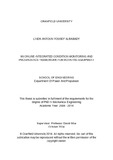JavaScript is disabled for your browser. Some features of this site may not work without it.
| dc.contributor.advisor | Mba, David | |
| dc.contributor.author | Alrabady, Linda Antoun Yousef | |
| dc.date.accessioned | 2015-05-28T11:41:47Z | |
| dc.date.available | 2015-05-28T11:41:47Z | |
| dc.date.issued | 2014-10 | |
| dc.identifier.uri | http://dspace.lib.cranfield.ac.uk/handle/1826/9204 | |
| dc.description.abstract | Detecting abnormal operating conditions, which will lead to faults developing later, has important economic implications for industries trying to meet their performance and production goals. It is unacceptable to wait for failures that have potential safety, environmental and financial consequences. Moving from a “reactive” strategy to a “proactive” strategy can improve critical equipment reliability and availability while constraining maintenance costs, reducing production deferrals, decreasing the need for spare parts. Once the fault initiates, predicting its progression and deterioration can enable timely interventions without risk to personnel safety or to equipment integrity. This work presents an online-integrated condition monitoring and prognostics framework that addresses the above issues holistically. The proposed framework aligns fully with ISO 17359:2011 and derives from the I-P and P-F curve. Depending upon the running state of machine with respect to its I-P and P-F curve an algorithm will do one of the following: (1) Predict the ideal behaviour and any departure from the normal operating envelope using a combination of Evolving Clustering Method (ECM), a normalised fuzzy weighted distance and tracking signal method. (2) Identify the cause of the departure through an automated diagnostics system using a modified version of ECM for classification. (3) Predict the short-term progression of fault using a modified version of the Dynamic Evolving Neuro-Fuzzy Inference System (DENFIS), called here MDENFIS and a tracking signal method. (4) Predict the long term progression of fault (Prognostics) using a combination of Autoregressive Integrated Moving Average (ARIMA)- Empirical Mode Decomposition (EMD) for predicting the future input values and MDENFIS for predicting the long term progression of fault (output). The proposed model was tested and compared against other models in the literature using benchmarks and field data. This work demonstrates four noticeable improvements over previous methods: (1) Enhanced testing prediction accuracy, (2) comparable processing time if not better, (3) the ability to detect sudden changes in the process and finally (4) the ability to identify and isolate the problem source with high accuracy. | en_UK |
| dc.language.iso | en | en_UK |
| dc.publisher | Cranfield University | en_UK |
| dc.rights | © Cranfield University 2014. All rights reserved. No part of this publication may be reproduced without the written permission of the copyright owner. | en_UK |
| dc.subject | Condition Monitoring | en_UK |
| dc.subject | Prognostics | en_UK |
| dc.subject | Short Term Prediction | en_UK |
| dc.subject | Long Term Prediction | en_UK |
| dc.subject | Online | en_UK |
| dc.subject | Automated Diagnostics | en_UK |
| dc.subject | Clustering | en_UK |
| dc.subject | Empirical Model Decomposition | en_UK |
| dc.subject | Autoregressive Moving Average | en_UK |
| dc.subject | Particle Swarm optimisation | en_UK |
| dc.subject | Fuzzy Logic | en_UK |
| dc.subject | Neural Network | en_UK |
| dc.title | An online-integrated condition monitoring and prognostics framework for rotating equipment | en_UK |
| dc.type | Thesis or dissertation | en_UK |
| dc.type.qualificationlevel | Doctoral | en_UK |
| dc.type.qualificationname | PhD | en_UK |
